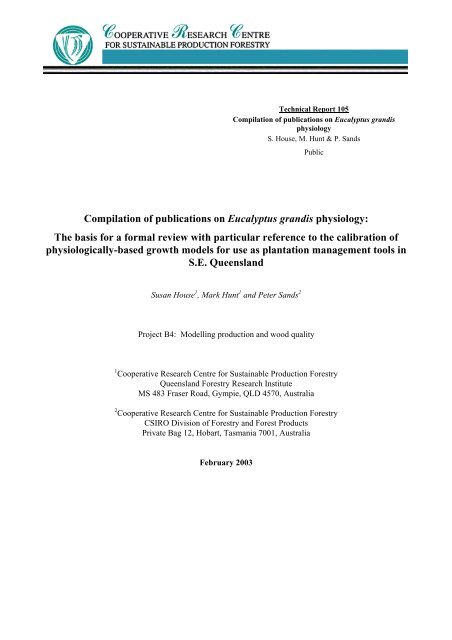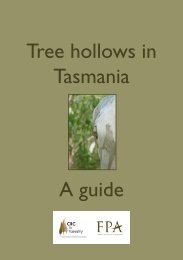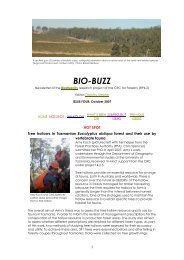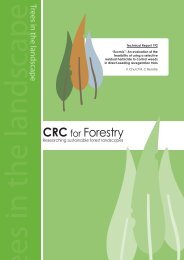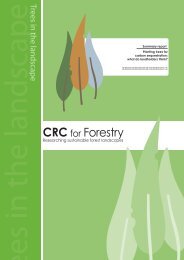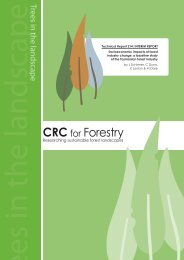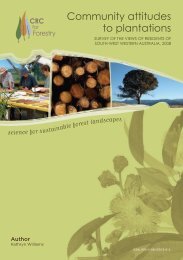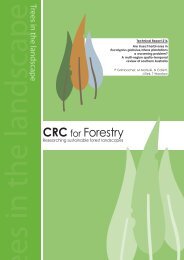Download public report. - CRC for Forestry
Download public report. - CRC for Forestry
Download public report. - CRC for Forestry
You also want an ePaper? Increase the reach of your titles
YUMPU automatically turns print PDFs into web optimized ePapers that Google loves.
Technical Report 105<br />
Compilation of <strong>public</strong>ations on Eucalyptus grandis<br />
physiology<br />
S. House, M. Hunt & P. Sands<br />
Public<br />
Compilation of <strong>public</strong>ations on Eucalyptus grandis physiology:<br />
The basis <strong>for</strong> a <strong>for</strong>mal review with particular reference to the calibration of<br />
physiologically-based growth models <strong>for</strong> use as plantation management tools in<br />
S.E. Queensland<br />
Susan House 1 , Mark Hunt 1 and Peter Sands 2<br />
Project B4: Modelling production and wood quality<br />
1 Cooperative Research Centre <strong>for</strong> Sustainable Production <strong>Forestry</strong><br />
Queensland <strong>Forestry</strong> Research Institute<br />
MS 483 Fraser Road, Gympie, QLD 4570, Australia<br />
2 Cooperative Research Centre <strong>for</strong> Sustainable Production <strong>Forestry</strong><br />
CSIRO Division of <strong>Forestry</strong> and Forest Products<br />
Private Bag 12, Hobart, Tasmania 7001, Australia<br />
February 2003
2<br />
Introduction<br />
The expansion of the hardwood plantation estate in Queensland is essential <strong>for</strong> the meeting of<br />
Australian national targets <strong>for</strong> af<strong>for</strong>estation over the next 20 years. Insufficient land availability in<br />
southern, temperate Australia and in the traditionally-planted humid coastal zone has <strong>for</strong>ced the<br />
prospectus-driven commercial plantation sector to expand increasingly into regions more marginal<br />
<strong>for</strong> plantation establishment, e.g. the subtropical 700 – 1000 mm rainfall zone (Loxton and Forster<br />
2000). In these regions, production is limited by low water availability and high evaporative<br />
demand (Sands et al. 1999), there is no history of plantation establishment, and few if any useful<br />
data exist pertaining to growth estimates or site indices <strong>for</strong> species of potential interest.<br />
Plantation establishment has grown rapidly in the tropical and subtropical region over the last three<br />
years, and accompanying this a significant amount of research has been undertaken covering a wide<br />
range of taxa, sites and silvicultural treatments (e.g. Lee et al. 1999; 2001). However, longer-term<br />
knowledge of eucalypt silviculture in these regions, necessary to drive selection and management<br />
decisions, is both very limited and restricted primarily to Eucalyptus grandis (Birk and Turner<br />
1992; Cromer and Jarvis 1990; Doley 1978) and E. camaldulensis (Blake 1980; Facanha et al.<br />
1983). Consequently, <strong>for</strong> the estimation of plantation per<strong>for</strong>mance in the immediate future,<br />
predictive models may constitute the most useful tools.<br />
In particular, there is an increasing potential <strong>for</strong> physiologically-based models to be used as<br />
powerful predictive tools in plantation selection and management (Battaglia and Sands 1997,<br />
1998a; Coops 1998a). While several such models have been used in the context of predicting<br />
per<strong>for</strong>mance, few have been routinely applied to decision-making in plantations (Sands 1988;<br />
Battaglia and Sands 1998; Sands et al. 2000). Managers require models with attributes such as<br />
simplicity of structure and of use, ease of validation within the relevant context, flexibility in terms<br />
of the questions they can address and a capacity to operate using readily available input data (Sands<br />
1988). However, <strong>for</strong> most physiological models, while input data such as weather records are easily<br />
obtained, other data required to set parameters and to validate models <strong>for</strong> new situations or species<br />
often are not. These parameters may include physiological responses to light, water-use efficiency<br />
characteristics, and growth rates. They may be obtained through physiological research, from<br />
growth plots or from the literature.<br />
Eucalyptus grandis is an important plantation species in both South Africa and South America,<br />
where it has and continues to be the subject of a considerable research ef<strong>for</strong>t, particularly in relation<br />
to its water-use characteristics (e.g. Dye 1996, Bevilaqua and Blake 1997, Esprey pers. comm.,
3<br />
Almeida pers. comm.). Despite the extensive work of Cromer et al. (1993; 1995), E. grandis has<br />
received on the whole much less attention in Australia. However, it remains arguably the most<br />
researched of the tropical/subtropical eucalypts in a field where there exists a dearth of both basic<br />
and applied physiological knowledge. This is particularly apparent when compared to the much<br />
better understood temperate commercial species (e.g. E. globulus, E. nitens). While E. grandis is<br />
considered primarily a pulp species in Australia, it is increasingly being considered <strong>for</strong> solid wood<br />
products in South America in response to periodic downturns in pulp and paper markets (Lima et al.<br />
2000). The substantial processing challenges <strong>for</strong> the industry presented by these short-rotation crops<br />
have resulted in heightened interest in the taxon’s physiology in recent years. Although the species<br />
has long been considered to possess significant potential <strong>for</strong> plantations in Australia, its variable<br />
per<strong>for</strong>mance across sites is well established (Cromer et al. 1991). It thus provides an excellent<br />
starting point to consider the usefulness of predictive models, both in terms of the quantity of<br />
available in<strong>for</strong>mation, and the known limitations of traditional empirical approaches to modelling<br />
its growth.<br />
Two physiological models potentially suitable <strong>for</strong> application to E. grandis are PROMOD (Battaglia<br />
and Sands 1997) and 3-PG (Landsberg and Waring 1997, Sands and Landsberg 2002). These are<br />
process-based models developed specifically <strong>for</strong> use as <strong>for</strong>est management tools. Sands (2001a)<br />
compares the per<strong>for</strong>mance of these models as tools <strong>for</strong> site selection. Both are generic models in the<br />
sense that application to a species requires the development of a set of parameters that characterise<br />
the species. However, many parameters in PROMOD are derived from physiological experiments,<br />
e.g. gas-exchange measurements, while those required <strong>for</strong> 3-PG are stand-level parameters often not<br />
accessible to direct measurement. The two models use very similar site and climatic input data.<br />
Both 3-PG and PROMOD can be used to screen sites on the basis of potential productivity, to predict<br />
stand development (but in radically different ways), and to determine which factors are likely to be<br />
limiting production. Both can be applied spatially to predict productivity across a landscape. 3-PG<br />
and PROMOD have been implemented in various ways, but both have been similarly implemented in<br />
Microsoft Excel in a <strong>for</strong>mat particularly convenient <strong>for</strong> parameter estimation and testing (Sands<br />
2001b, Sands 2002).<br />
In preparation <strong>for</strong> the adaptation of these models to E. grandis, a substantial literature search of<br />
<strong>public</strong>ations relevant to E. grandis physiology, effects of silviculture and climatic conditions on<br />
growth and development of E. grandis stands, the availability of E. grandis growth data, and prior<br />
application of growth models to E. grandis has been carried out. This material will be used as the
4<br />
basis of a review of E. grandis physiology, and <strong>for</strong> the adaptation of the two models to this species.<br />
The Appendix of this <strong>report</strong> is a compilation of the material to hand at the time of writing (July<br />
2002).<br />
Reference list<br />
Battaglia, M. and Sands, P. (1997). Modelling site productivity of Eucalyptus globulus in response to climatic and site<br />
factors. Aust. J. Plant Physiol. 24: 831-850.<br />
Battaglia, M. and Sands, P. J. (1998). Process-based <strong>for</strong>est productivity models and their application in <strong>for</strong>est<br />
management. Forest Ecology and Management 102: 13-32.<br />
Bevilaqua, E. and Blake, T. J. (1997). Modelling growth and ecophysiological responses of Eucalyptus grandis clones<br />
in Minas Gerais, Brazil. Journal of Tropical Forest Science 9: 505-513.<br />
Blake, T. J. (1980). Effect of coppicing on growth rates, stomatal characteristics and water relations in Eucalyptus<br />
camaldulensis Dehn. Australian Journal of Plant Physiology, 81 - 87.<br />
Birk, E. and Turner, J. (1992). Response of flooded gum (E. grandis) to intensive cultural treatments: biomass and<br />
nutrient content of eucalypt plantations and native <strong>for</strong>ests. Forest Ecology and Management 47: 1-28.<br />
Coops, N.C., Waring, R.H., Landsberg, J.J. (1998a). Assessing <strong>for</strong>est productivity in Australia and New Zealand using<br />
a physiologically-based model driven with averaged monthly weather data and satellite-derived estimates of canopy<br />
productivity. For. Ecol. Manage. 104, 113-127.<br />
Cromer, R. N. and Jarvis, P. G. (1990). “Growth and biomass partitioning in Eucalyptus grandis seedlings in response<br />
to nitrogen supply.” Austral. J. Plant Physiol. 17: 503-515.<br />
Cromer, R. N., Cameron, D. M., Lennon, S., Rance, S. J., Ryan, P. A. and West, P. (1995). Response of E. grandis to<br />
fertilizer and irrigation, to five years of age., CSIRO Division of <strong>Forestry</strong>.<br />
Cromer, R. N., Cameron, D. M., Rance, S. J., Ryan, P. A. and Brown, M. (1993). “Response to nutrients in Eucalyptus<br />
grandis. I. Biomass accumulation.” Forest Ecology and Management 62: 211-230.<br />
Cromer, R. N., Ryan, P. A., Booth, T. H., Cameron, D. M. and Rance, S. J. (1991). Limitations to productivity of<br />
Eucalyptus grandis plantations in sub-tropical Australia. Third Australian Forest Soils and Nutrition Conference.<br />
Doley, D. (1978). “Effects of shade on gas exchange and growth in seedlings of Eucalyptus grandis Hill ex Maiden.”<br />
Aust.J. Plant Physiol. 5: 723-38.<br />
Dye, P. J. (1996). “Response of Eucalyptus grandis trees to soil water deficits.” Tree Physiology 16: 223-238.<br />
Facanha, J., Oliva, M. A., Lopes, N. F., and de, B. N. F. (1983). Germination/growth relation in eucalypt species under<br />
water stress. Revista-Arvore 7, 177 - 187.<br />
Landsberg, J. J. and Waring, R. H. (1997). “A generalised model of <strong>for</strong>est productivity using simplified concepts of<br />
radiation-use efficiency, carbon balance and partitioning.” Forest Ecology and Management 95: 209-228.
5<br />
Lee, D.J., Nikles, D.G. and Dickinson, G.R. (2001) Prospects of eucalypt species, including interspecific hybrids from<br />
South Africa, <strong>for</strong> hardwood plantations in marginal subtropical environments in Queensland, Australia. Southern<br />
African <strong>Forestry</strong> Journal 190: 89-94.<br />
Lee, D.J., Nikles, D.G. and Walker, S.M. (1999). Strategy and progress on the genetic improvement of hardwood<br />
timber species in Queensland. In: Langridge, P., Barr, A., Auricht, G., Collins, G., Granger, A., Hand<strong>for</strong>d, D. and<br />
Paull, J. (eds.) 11 th Australian Plant Breeding Conference Proceedings, Adelaide, 19-23 April 1999 – Volume 2.<br />
Lima, J.T., Breese, M.C. and Cahalan, C.M. (2000) Variation in wood density and mechanical properties in Eucalyptus<br />
clones. In: The future of eucalypts <strong>for</strong> word products - Proceedings of IUFRO meeting, Launceston, Australia, 19-24<br />
March.<br />
Loxton, I., and Forster, S. (2000). “Brigalow Research Station Technical Report 1999-2000,” Rep. No. Q100098.<br />
Queensland Beef Industry Institute, Department of Primary Industries, Queensland, Theodore.<br />
Sands, P. (1988). “Resource modelling: its nature and use.” Mem. Ent. Soc. Can. 143: 5-10.<br />
Sands, P.J. (2001a). Productivity models - a comparative analysis. Technical Report No. 55 (M. Cherry and C. Beadle<br />
Eds) pp 51-54. (<strong>CRC</strong>-SPF, Hobart, Tasmania).<br />
Sands, PJ. (2001b). 3PGpjs 1.1 – a User-Friendly Interface to 3-PG, the Landsberg and Waring Model of Forest<br />
Productivity. Technical Report. No. 29, <strong>CRC</strong> Sustainable Production <strong>Forestry</strong>, Hobart.<br />
Sands, PJ. (2002). PROMOD Excel – a User-Friendly Interface to PROMOD. Technical Report. No. 88, <strong>CRC</strong> Sustainable<br />
Production <strong>Forestry</strong>, Hobart.<br />
Sands, P.J. and Landsberg, J.J. (2002). Parameterisation of 3-PG <strong>for</strong> plantation grown Eucalyptus globulus. Forest<br />
Ecology and Management, 163: 273-292<br />
Sands, P.J., Rawlins, W. and Battaglia, M. (1999). Use of a simple plantation productivity model to study the<br />
profitability of irrigated Eucalyptus globulus. Ecological Modelling, 117:125-141.<br />
Sands, P.J., Battaglia, M. and Mummery, D. (2000). Application of process-based models to <strong>for</strong>est management:<br />
Experience with PROMOD, a simple plantation productivity model. Tree Physiology, 20: 383-392
6<br />
Appendix : Compilation of References<br />
Alexander, T. G. and Thomas, T. P. (1985). Physical Properties of Soils in Relation to Eucalypt Growth, Kerala Forest<br />
Resarch Institute, Divsion of Soil Science.<br />
Attiwell, P. M. and Adams, M. A., Eds. (1996). Nutrition of Eucalypts, CSIRO Publishing.<br />
Baldwin, P. J. and H. T. L. Stewart (1987). “Distribution, Length and Weight of Roots in Young Plantations of<br />
Eucalyptus grandis W-Hill Ex Maiden Irrigated with Recycled Water.” Plant and Soil 97(2): 243-252.<br />
Barnard, E. L., T. Geary, et al. (1987). “Basal Cankers and Coppice Failure of Eucalyptus grandis in Florida.” Plant<br />
Disease 71(4): 358-361.<br />
Battaglia, M. and Sands, P. (1997). Modelling site productivity of Eucalyptus globulus in response to climatic and site<br />
factors. Aust. J. Plant Physiol. 24: 831-850.<br />
Battaglia, M. and Sands, P. J. (1998). Process-based <strong>for</strong>est productivity models and their application in <strong>for</strong>est<br />
management. Forest Ecology and Management 102: 13-32.<br />
Battaglia, M. and Sands, P.J. (1998). Application of sensitivity analysis to a model of Eucalyptus globulus plantation<br />
productivity. Ecological Modelling 111: 237-259.<br />
Battaglia, M., Beadle, C. and Loughead, S. (1996). Photosynthetic temperature responses of Eucalyptus globulus and<br />
Eucalyptus nitens. Tree Physiology 16: 81-89.<br />
Battaglia, M., D. Mummery, and A. Smith. (2001). Economic analysis of site survey and productivity modelling <strong>for</strong> the<br />
selection of plantation areas. Forest Ecology and Management (in press).<br />
Battaglia, M., Sands, P.J. and Candy, S.G. (1999). Hybrid growth model to predict height and volume growth in young<br />
Eucalyptus globulus plantations. Forest Ecology and Management, 120: 193-201.<br />
Beadle, C. L. and Turnbull, C. R. A. (1992). Comparative growth rates of Eucalyptus in native <strong>for</strong>est and plantation<br />
monoculture. Growth and water use of <strong>for</strong>est plantations. Calder, I. R., Hall, R. L. and Adlard, P. G., John Wiley<br />
and Sons: 318-331.<br />
Benyon, R. G. (1999). “Nighttime water use in an irrigated Eucalyptus grandis plantation.” Tree Physiology 19(13):<br />
853-859.<br />
Bevilaqua, E. and Blake, T. J. (1997). Modelling growth and ecophysiological responses of Eucalyptus grandis clones<br />
in Minas Gerais, Brazil. Journal of Tropical Forest Science 9: 505-513.<br />
Birk, E. and Turner, J. (1992). Response of flooded gum (E. grandis) to intensive cultural treatments: biomass and<br />
nutrient content of eucalypt plantations and native <strong>for</strong>ests. Forest Ecology and Management 47: 1-28.<br />
Boden, D. I. (1987). The use of actual evapotranspiration and a hydrological model to predict the growth of Eucalyptus<br />
grandis in South Africa. Institute of Commercial <strong>Forestry</strong> Research (ICFR).<br />
Boden, D. I. (1991). “The relationship between soil water status, rainfall and the growth of Eucalyptus grandis.” South<br />
African <strong>Forestry</strong> Journal 156: 49-55.
7<br />
Bonny, L. (1991). Growth of a Eucalyptus grandis plantation following intensive silvicultural treatments applied in the<br />
first six years. Sydney, <strong>Forestry</strong> Commission of NSW.<br />
Bradstock, R. (1981). “Biomass in an age series.” Aus. For. Res. 11: 111-127.<br />
Bredenkamp, B. V. and H. E. Burkhart (1990). “An Examination of Spacing Indexes <strong>for</strong> Eucalyptus grandis.”<br />
Canadian Journal of Forest Research 20(12): 1909-1916.<br />
Burgess, I. P. (1988). “Provenance trials of Eucalyptus grandis and E. saligna in Australia.” Silvae Genetica 37: 5-6.<br />
Byrne, G. F. (1989). “Above-Ground Dry-Matter Accumulation by Eucalyptus grandis and Its Relation to Standard<br />
Meteorological Data.” Agricultural and Forest Meteorology 46(1-2): 65-73.<br />
Calder, I. R. (1992). “Deuterium tracing <strong>for</strong> the estimation of transpiration from trees. Part 2: Estimation of<br />
transpiration rates and transpiration parameters using a time-averaged deuterium tracing methods.” Journal of<br />
Hydrology 130: 27-35.<br />
Calder, I. R., Swaminath, M. H., Kariyappa, G. S., Srinivasalu, N. V., Srinivasa Murthy, K. V. and Mumtaz, J. (1992).<br />
“Deuterium tracing <strong>for</strong> the estimation of transpiration from trees Part 3. Measurements of transpiration from<br />
Eucalyptus plantation, India.” Journal of Hydrology 130: 37-48.<br />
Carvalho, R., Furtini-Neto, A.E., Santos, C.D. dos, Fernandes, L.A., Curi, N., Rodrigues, D. de C., de C. Rodrigues, D.<br />
and dos Santos, C.D. (2001) Silicon-phosphorus interactions in soils cultivated with eucalyptus under greenhouse<br />
conditions. Pesquisa Agropecuaria Brasileira 36 (3), 557-565.<br />
Christie, S. I. and Scholes, R. J. (1995). “Carbon storage in Eucalyptus and pine plantations in South Africa.”<br />
Environmental Monitoring and Assessment 38: 231-241.<br />
Clearwater, M. J. and F. C. Meinzer (2001). “Relationships between hydraulic architecture and leaf photosynthetic<br />
capacity in nitrogen-fertilized Eucalyptus grandis trees.” Tree Physiology 21(10): 683-690.<br />
Clemens, J., Kirk, A. and Mills, P. (1978). “The resistance of waterlogging and an ethylene-releasing substance on E.<br />
robusta, E. grandis and E. saligna.” Oecologia 34: 125-131.<br />
Comer, C. W. and Rockwood, D. L. (1985). Screening of Eucalyptus species <strong>for</strong> coppice productivity. 1984 Southern<br />
Forest Biomass Workshop, Asheville, NC USA.<br />
Coops, N.C. and Waring, R.H. (2001). Estimating Maximum Potential Site Productivity and Site Water Stress of the<br />
Eastern Siskiyous using 3-PGS. Canadian Journal of Forest Research 31: 143-154.<br />
Coops, N.C., Waring, R.H., Landsberg, J.J. (1998). Assessing <strong>for</strong>est productivity in Australia and New Zealand using a<br />
physiologically-based model driven with averaged monthly weather data and satellite-derived estimates of canopy<br />
productivity. For. Ecol. Manage. 104, 113-127.<br />
Coops, N.C., Waring, R.H. and Landsberg, J.J. (1998). The development of a physiological model (3-PGS) to predict<br />
<strong>for</strong>est productivity using satellite data. In: G. Nabuurs, T. Nuutinen, H. Bartelink, & M. Koorhonen, eds. Forest<br />
Scenario Modelling <strong>for</strong> Ecosystem Management at Landscape Level. pp. 173 -191. EFI Proceedings.
8<br />
Criddle, R.S., Church, J.N., Hansen, D., Mitchell, A.K., Puttonen, P., Stoehr, M. and Hawkins, B.J. (2000) Respiratory<br />
parameters define growth rate, species distribution and adaptation to temperature. Journal of Sustainable <strong>Forestry</strong><br />
10(1-2): 115-123.<br />
Cromer, R. N. and Jarvis, P.G. (1989). “Allocation of Dry-Matter in Eucalyptus grandis Seedlings in Response to<br />
Nitrogen Supply.” Annales Des Sciences Forestieres 46: S680-S683.<br />
Cromer, R. N. and P. G. Jarvis (1990). “Growth and Biomass Partitioning in Eucalyptus grandis Seedlings in Response<br />
to Nitrogen Supply.” Australian Journal of Plant Physiology 17(5): 503-515.<br />
Cromer, R. N., Cameron, D. M., Lennon, S., Rance, S. J., Ryan, P. A. and West, P. (1995). Response of E. grandis to<br />
fertilizer and irrigation, to five years of age., CSIRO Division of <strong>Forestry</strong>.<br />
Cromer, R. N., Cameron, D. M., Rance, S. J., Ryan, P. A. and Brown, M. (1993). “Response to nutrients in Eucalyptus<br />
grandis. I. Biomass accumulation.” Forest Ecology and Management 62(1-4): 211-230.<br />
Cromer, R. N., Cameron, D. M., Rance, S. J., Ryan, P. A. and Brown, M. (1993). “Response to Nutrients in Eucalyptus<br />
grandis.2. Nitrogen Accumulation.” Forest Ecology and Management 62(1-4): 231-243.<br />
Cromer, R. N., Ryan, P. A., Booth, T. H., Cameron, D. M. and Rance, S. J. (1991). Limitations to productivity of<br />
Eucalyptus grandis plantations in sub-tropical Australia. Third Australian Forest Soils and Nutrition Conference.<br />
Darrow, W. K. (1984). “Biomass production of Eucalyptus grandis in South Africa planted at various close<br />
espacements: Two-year results.” South African Journal of <strong>Forestry</strong> 131: 34-39.<br />
Davidson, N. J., Battaglia, M. and Beadle, C. (1995). Photosynthesis of Eucalyptus nitens is reduced by mild frosts.<br />
Eucalypt plantations, improving fibre yield and quality. Proc. <strong>CRC</strong>THF-IUFRO Conference, Hobart, <strong>CRC</strong> <strong>for</strong><br />
Temperate Hardwood <strong>Forestry</strong>: Hobart.<br />
Dawson, T. E. and Pate, J. S. (1996). “Seasonal water uptake and movement in root systems of Australian<br />
phraeatophytic plants of dimorphic root morphology: a stable isotope investigation.” Oecologia 107: 113-20.<br />
Doley, D. (1978). “Effects of shade on gas exchange and growth in seedlings of Eucalyptus grandis Hill ex Maiden.”<br />
Aust.J. Plant Physiol. 5: 723-38.<br />
Doley, D. (1982). “Photosynthetic productivity of <strong>for</strong>est canopies in relation to solar radiation and nitrogen cycling.”<br />
Aust. For. Res. 12: 245-61.<br />
Dudley, N. S. and Fownes, J. H. (1993). “Preliminary biomass equations <strong>for</strong> eight species of fast-growing tropical<br />
trees.” Journal of Tropical Forest Science 5(1): 68-73.<br />
Dye, P. J. (1987). Estimating water use by Eucalyptus grandis with the Penman-Monteith equation. Forest Hydrology<br />
and Watershed Management, Vancouver, International Association of Hydrological Sciences (IAHS).<br />
Dye, P. J. (1996). “Response of Eucalyptus grandis trees to soil water deficits.” Tree Physiology 16(1-2): 233-238.<br />
Dye, P. J. and Olbrich, B. W. (1992). Heat Pulse observations of Eucalyptus grandis transpiration in South Africa.<br />
Growth and Water Use of Forest Plantations. Calder, I. R., Hall, R. L. and Adlard, P. G., John Wiley and Sons: 216-<br />
225.
9<br />
Dye, P. J. and B. W. Olbrich (1993). “Estimating Transpiration from 6-Year-Old Eucalyptus grandis Trees -<br />
Development of a Canopy Conductance Model and Comparison with Independent Sap Flux Measurements.” Plant<br />
Cell and Environment 16(1): 45-53.<br />
Dye, P. J., Olbrich, B. W. and Calder, I. R. (1992). “A comparison of the Heat Pulse Method and Deteurium Tracing<br />
Method <strong>for</strong> measuring transpiration from Eucalyptus grandis trees.” Journal of Experimental Botany 43 (248): 337-<br />
343.<br />
Eastham, J., Rose, C. W., Cameron, D. M., Rance, S. J., Talsma, T. and Charles-Edwards, D. A. (1990). “Tree/pasture<br />
interactions at a range of tree densities in an agro<strong>for</strong>estry experiment. II Water uptake in relation to rooting<br />
patterns.” Aust. J. Agric. Res. 41: 697-707.<br />
Eastham, J., Rose, C. W., Cameron, D. M., Rance, S. J., Talsma, T. and Charles-Edwards, D. A. (1990). “Tree/pasture<br />
interactions at a range of tree densities in an agro<strong>for</strong>estry experiment. III Water uptake in relation to soil hydraulic<br />
conductivity and rooting patterns.” Aust. J. Agric. Res. 41: 709-718.<br />
Facanha, J., Oliva, M. A., Lopes, N. F., and de, B. N. F. (1983). Germination/growth relation in eucalypt species under<br />
water stress. Revista-Arvore 7, 177 - 187.<br />
Fan, S. and Blake, T. J. (1997). “Comparison of polyethylene glycol 3350 induced osmotic stress and soil drying <strong>for</strong><br />
drought simulation in three woody species.” Trees 11: 342-348.<br />
Flanagan, L. B. and Ehrlinger, J. R. (1991). “Stable isotope composition of stem and leaf water: applications to the<br />
study of plant water use.” Functional Ecology 5: 270-277.<br />
Folster, H. v. and Khanna, P. K. (1997). Dynamics of Nutrient Supply in Plantation Soils. Management of Soil,<br />
Nutrients and Water in Tropical Plantation Forests. Nambiar, E. K. S. and Brown, A. G. Canberra, CSIRO: 339-<br />
378.<br />
Haigh, H. (1966). “Root development in the sandy soils of Zululand.” <strong>Forestry</strong> in South Africa 7: 31-36.<br />
Henri, C. J. (2001). “Soil-site productivity of Gmelina arborea, Eucalyptus urophylla and Eucalyptus grandis <strong>for</strong>est<br />
plantations in western Venezuela.” Forest Ecology and Management 144(1-3): 255-264.<br />
Herbert, M. A. (1990). “Fertilizer Site Interactions on the Growth and Foliar Nutrient Levels of Eucalyptus grandis.”<br />
Forest Ecology and Management 30(1-4): 247-257.<br />
Hoad, S. P. and R. R. B. Leakey (1994). “Effects of Light Quality on Gas-Exchange and Dry-Matter Partitioning in<br />
Eucalyptus grandis W Hill Ex Maiden.” Forest Ecology and Management 70(1-3): 265-273.<br />
Hoad, S. P. and R. R. B. Leakey (1996). “Effects of pre-severance light quality on the vegetative propagation of<br />
Eucalyptus grandis W Hill ex Maiden - Cutting morphology, gas exchange and carbohydrate status during rooting.”<br />
Trees-Structure and Function 10(5): 317-324.<br />
Honeysett, J. L., Beadle, C. L. and Turnbull, C. R. A. (1991). “Evapotranspiration and growth of two contrasting<br />
species of eucalypts under non-limiting and limitinga water availability.” Forest Ecology and Management.
10<br />
Hopmans, P., Stewart, H. T. L., Flynn, D. W. and Hillman, T. J. (1990). “Growth, biomass production and nutrient<br />
accumulation by seven tree species irrigated with municipal effluent at Wodonga, Australia.” Forest Ecology and<br />
Management 30: 203-211.<br />
House, S. M. (1999). Calibration of 3-PG <strong>for</strong> Eucalyptus grandis using Shell data at Toolara, SE Queensland., QFRI,<br />
Draft Report, Gympie.<br />
Hunter, I. (2001). “Above ground biomass and nutrient uptake of three tree species (Eucalyptus camaldulensis,<br />
Eucalyptus grandis and Dalbergia sissoo) as affected by irrigation and fertiliser, at 3 years of age, in southern<br />
India.” Forest Ecology and Management 144(1-3): 189-199.<br />
Hutchinson, M.F., Houlder D., Nix, H.A. and McMahon, J.P. (1997). ANUCLIM Version 1.5. CRES, ANU, Canberra.<br />
Published at http//cres20.anu.edu.au/software/anuclim.html<br />
Johnson, I. G. and Stanton, R. R. (1993). Thirty years of eucalypt species and provenance trials in New South Wales.<br />
Survival and growth in trials established from 1961 to 1990. Sydney, <strong>Forestry</strong> Commission of New South Wales.<br />
Research Division.<br />
Kallarackal, J. (1992). Water use of eucalypts in Kerala. Growth and water use of <strong>for</strong>est plantations. Calder, I. R., Hall,<br />
R. L. and Adlard, P. G., John Wiley and Sons: 290-297.<br />
Kallarackal, J. and C. K. Somen (1997). “An ecophysiological evaluation of the suitability of Eucalyptus grandis <strong>for</strong><br />
planting in the tropics.” Forest Ecology and Management 95(1): 53-61.<br />
Kalma, S. J., Thorburn, P. J. and Dunn, G. M. (1998). “A comparison of heat pulse and deuterium tracing techniques <strong>for</strong><br />
estimating sap flow in Eucalyptus grandis trees.” Tree Physiology 18: 697-705.<br />
Kirschbaum, M. U. F. (1991). “Effects of Photon Flux-Density on Nutrient Productivity in Eucalyptus grandis<br />
Seedlings.” Australian Journal of Plant Physiology 18(3): 307-315.<br />
Kirschbaum, M. U. F. and D. Tompkins (1990). “Photosynthetic Responses to Phosphorus-Nutrition in Eucalyptus<br />
grandis Seedlings.” Australian Journal of Plant Physiology 17(5): 527-535.<br />
Kirschbaum, M. U. F., D. W. Bellingham, et al. (1992). “Growth Analysis of the Effect of Phosphorus-Nutrition on<br />
Seedings of Eucalyptus grandis.” Australian Journal of Plant Physiology 19(1): 55-66.<br />
Laine, E. and A. David (1994). “Regeneration of Plants from Leaf Explants of Micropropagated Clonal Eucalyptus<br />
grandis.” Plant Cell Reports 13(8): 473-476.<br />
Landsberg, J.J. and Gower, S. T. (1997). Applications of Physiological Ecology to Forest Mangement. San Diego,<br />
Academic Press.<br />
Landsberg, J.J. and Hingston, F. J. (1996). “Evaluating a simple radiation/dry matter conversion model using data from<br />
Eucalyptus globulus plantations in Western Australia.” Tree Physiology 16: 801-808.<br />
Landsberg, J.J. and Waring, R. H. (1997). “A generalised model of <strong>for</strong>est productivity using simplified concepts of<br />
radiation-use efficiency, carbon balance and partitioning.” Forest Ecology and Management 95: 209-228.
11<br />
Landsberg, J.J. (1998). Assessing <strong>for</strong>est productivity in Australia and New Zealand using a physiologically-based<br />
model driven with averaged monthly weather data and satellite-derived estimates of canopy productivity. For. Ecol.<br />
Manage. 104, 113-127.<br />
Landsberg, J.J., Johnson, K.H., Albaugh, T.J., Allen, H.L. and McKeand, S.E. (2000). Applying 3-PG, a simple<br />
process-based model designed to produce practical results, to data from loblolly pine experiments. For. Sci. (in<br />
press).<br />
Lang, A. R. G. and McMurtrie, R. E. (1992). “Total leaf areas of single trees of Eucalyptus grandis estimated from<br />
transmittances of the sun's beam.” Agricultural and Forest Meteorology 58: 79-92.<br />
Law, B.E., Waring, R.H., Anthoni, P.M. and Aber, J.D. (2000). Measurements of gross and net ecosystem productivity<br />
and water vapour exchange of a Pinus ponderosa ecosystem, and an evaluation of two generalized models. Global<br />
Change Biol. 6:155-168.<br />
Le Maitre, D.C. and Versfeld, D.B. (1997). “Forest evaporation models: relationships between stand growth and<br />
evaporation.” Journal of Hydrology 193: 240-257.<br />
Le Roux, D., Stock, W. D., Bond, W. J. and Maphanga, D. (1996). “Dry mass allocation, water use efficiency and 13C<br />
in clones of Eucalyptus grandis, E. grandis x camaldulensis and E. grandis x nitens grown under two irrigation<br />
regimes.” Tree Physiology 16: 497 - 502.<br />
Lee, D., Ryan, P., and Nikles, G. (1997). Provenance variation of Eucalyptus cloeziana exhibited at Pomona in South<br />
eastern Queensland. In “Overcoming impediments to re<strong>for</strong>estation : tropical <strong>for</strong>est rehabilitation in the Asia-Pacific<br />
region, proceedings of the 6th International Workshop of Bio-Re<strong>for</strong>, Brisbane, Australia” (E. J. K. e. al.], ed.).<br />
Brisbane, Qld. : BIO-REFOR, 1998., Australia.<br />
Lesch, W. and D. F. Scott (1997). “The response in water yield to the thinning of Pinus radiata, Pinus patula and<br />
Eucalyptus grandis plantations.” Forest Ecology and Management 99(3): 295-307.<br />
Leuning, R. (1990). “Modeling Stomatal Behavior and Photosynthesis of Eucalyptus grandis.” Australian Journal of<br />
Plant Physiology 17(2): 159-175.<br />
Leuning, R. (1995). “A critcal appraisal of a combined stomata-photosynthesis model <strong>for</strong> C plants.” Plant, Cell and<br />
3<br />
Environment. 18: 339-355.<br />
Leuning, R., Wang, Y. P. and Cromer, R. N. (1990). Model simulations of spatial distributions and daily totals of<br />
photosynthesis in Eucalyptus grandis canopies. Shell Hardwood Plantation Development Project. Final Report,<br />
CSIRO Division of <strong>Forestry</strong> and Forest Products.<br />
Leuning, R., Wang, Y. P. and Cromer, R. N. (1991). “Model simulations of spatial distributions and daily totals of<br />
photosynthesis in Eucalyptus grandis canopies.” Oecologia 88: 494-503.<br />
Lima, W. d. P., Zakia, M. J., Libardi, P. L. and Filho, A. P. d. S. (1990). “Comparative evapotranspiration of<br />
eucalyptus, pine and natural 'Cerrado' vegetation measured by the soil water balance method.” Piracicaba, IPEF<br />
International 1: 5-11.
12<br />
Loxton, I., and Forster, S. (2000). “Brigalow Research Station Technical Report 1999-2000,” Rep. No. Q100098.<br />
Queensland Beef Industry Institute, Department of Primary Industries, Queensland, Theodore.<br />
Mabvurira, D. and J. Miina (2002). “Individual-tree growth and mortality models <strong>for</strong> Eucalyptus grandis (Hill) Maiden<br />
plantations in Zimbabwe.” Forest Ecology and Management 161(1-3): 231-245.<br />
McAlpine, J.R. (1970). Estimating pasture growth periods and droughts from simple water balance models. In “XI<br />
International Grasslands Congress”, Surfers Paradise, Queensland (Ed. M. J. T. Norman) pp. 484-487.<br />
Medhurst, J. L., Battaglia, M., Cherry, M. L., Hunt, M. A., White, D. A. and Beadle, C. L. (1999). “Allometric<br />
relationships <strong>for</strong> Eucalyptus nitens (Deane and Maiden) Maiden plantations.” Trees 14: 91-101.<br />
Medlyn, B. E. (1996). “Interactive effects of atmospheric carbon dioxide and leaf nitrogen concentration on canopy<br />
light use effciency: a modeling analysis.” Tree Physiology 16: 201-209.<br />
Mens<strong>for</strong>th, L., Thorburn, P. J., Tyerman, S. D. and Walker, G. R. (1994). “Sources of water used by riparian Eucalyptus<br />
camaldulensis overlying saline groundwater.” Oecologia 100: 21-28.<br />
Michelozzi, M., Johnson, J. D. and Warrag, E. I. (1995). “Response of ethylene and chlorophyll in two eucalyptus<br />
clones during drought.” New Forests 9: 197-204.<br />
Mielke, M. S., Oliva, M. A., de Barros, N. F., Penchel, R. M., Martinez, C. A. and de Almeida, A. C. (1999). “Stomatal<br />
control of transpiration in the canopy of a clonal Eucalyptus grandis plantation.” Trees 13: 152-160.<br />
Mousa, A. and Keady, E. (1998). Plantation volume growth summaries from growth plots in Queensland. Brisbane, DPI<br />
<strong>Forestry</strong>.<br />
Mummery, D. and Battaglia, M. (2000). Applying PROMOD spatially across Tasmania with sensitivity analysis to<br />
screen <strong>for</strong> prospective Eucalyptus globulus plantation sites. Forest Ecology and Management 140:51-63.<br />
Myers, B. J., Benyon, R.G. Theiveyanathan, S., Criddle, R.S., Smith, C.J., and Falkiner, R.A (1998).<br />
“Response of effluent-irrigated Eucalyptus grandis and Pinus radiata to salinity and vapor pressure deficits.” Tree<br />
Physiology 18(8-9): 565-573.<br />
Myers, B. J., Theiveyanathan, S., O'Brien, N. D. and Bond, W. J. (1996). “Growth and water use of Eucalyptus grandis<br />
and Pinus radiata plantations irrigated with effluent.” Tree Physiology 16: 211-219.<br />
Olbrich, B. W. (1991). “The Verification of the Heat Pulse Velocity Technique <strong>for</strong> Estimating Sap Flow in Eucalyptus<br />
grandis.” Canadian Journal of Forest Research 21(6): 836-841.<br />
Olbrich, B., Leroux, W.D., Poulter, A.G., Bond, W.J. and Stock, W.D. (1993). “Variation in Water-Use Efficiency and<br />
Delta-C-13 Levels in Eucalyptus grandis Clones.” Journal of Hydrology 150(2-4): 615-633.<br />
Ozkurt, N., Gulbaba, A.G., Ozkurt, A. and Tufekci, S. (1998) Phenological observations on Eucalyptus (E.<br />
camaldulensis and E. grandis). Teknik Bulten Orman Bakanligi Dogu Akdeniz Ormancilik Arastirma Enstitusu No<br />
8, 46pp.<br />
Rance, S. J., Cromer, R. N., Cameron, D. M. and E.R., W. (1990). Response of young Eucalyptus grandis to fertilizer<br />
treatments. I Biomass, leaf area, volume and wood density. Shell Hardwood Plantation Development Project. Final<br />
Report, CSIRO Division of <strong>Forestry</strong> and Forest Products.
13<br />
Rockwood, D. L. and Dippon, D. R. (1989). “Biological and economic potentials of Eucalyptus grandis and slash pine<br />
as biomass energy crops.” Biomass 20: 155-165.<br />
Sands, P. (1988). “Resource modelling: its nature and use.” Mem. Ent. Soc. Can. 143: 5-10.<br />
Sands, P.J., Battaglia, M. and Mummery, D. (2000). Application of process-based models to <strong>for</strong>est management:<br />
Experience with PROMOD, a simple plantation productivity model. Tree Physiology, 20: 383-392<br />
Sands, P. J., R. N. Cromer, et al. (1992). “A Model of Nutrient Response in Eucalyptus grandis Seedlings.” Australian<br />
Journal of Plant Physiology 19(5): 459-470.<br />
Sands, P.J. (1995). “Modelling canopy production. II. From single-leaf photosynthetic parameters to daily canopy<br />
photosynthesis.” Aust. J. Plant Physiol. 22: 603-614.<br />
Sands, P.J. (1996). “Modelling canopy production. III. Canopy light-utilisation efficiency and its sensitivity to<br />
physiological and environmental variables.” Aust. J. Plant Physiol. 23: 103-114.<br />
Sands, P.J. (2001). Productivity models - a comparative analysis. Technical Report No. 55 (M. Cherry and C. Beadle<br />
Eds) pp 51-54. (<strong>CRC</strong>-SPF, Hobart, Tasmania).<br />
Sands, P.J. and Landsberg, J.J. (2002). Parameterisation of 3-PG <strong>for</strong> plantation grown Eucalyptus globulus. Forest<br />
Ecology and Management, 163: 273-292<br />
Sands, P.J., Rawlins, W. and Battaglia, M. (1999). Use of a simple plantation productivity model to study the<br />
profitability of irrigated Eucalyptus globulus. Ecological Modelling, 117:125-141.<br />
Sands, PJ. (2001). 3PGpjs 1.1 – a User-Friendly Interface to 3-PG, the Landsberg and Waring Model of Forest<br />
Productivity. Technical Report. No. 29, <strong>CRC</strong> Sustainable Production <strong>Forestry</strong>, Hobart.<br />
Sands, PJ. (2002). PROMOD Excel – a User-Friendly Interface to PROMOD. Technical Report. No. 88, <strong>CRC</strong> Sustainable<br />
Production <strong>Forestry</strong>, Hobart.<br />
Schonau, A. P. G. (1984). “A Factorial Thinning Experiment in Eucalyptus grandis.” Commonwealth <strong>Forestry</strong> Review<br />
63(4): 285-295.<br />
Schonau, A. P. G. (1984). “Silvicultural Considerations <strong>for</strong> High Productivity of Eucalyptus grandis.” Forest Ecology<br />
and Management 9(4): 295-314.<br />
Schubert, T. H., Strand, R. F., Cole, T. G. and Macduffie, K. E. (1988). “Equations <strong>for</strong> predicting biomass of six<br />
introduced tree species, island of Hawaii.” Research Note Pacific Southwest. 401.<br />
Scott, D. F. and Lesch, W. (1997). “Streamflow responses to af<strong>for</strong>estation with Eucalyptus grandis and Pinus patula<br />
and to felling in the Mokobulaan experimental catchments, South Africa.” Journal of Hydrology 199: 360-377.<br />
Sheriff, D. W. and Nambiar, E. K. S. (1991). “Nitrogen nutrition, growth and gas exchange in Euclayptus globulus<br />
Labill. seedlings.” Aust. J. Plant Physiology 18: 37-52.<br />
Silva, W. da, Silva, A.A. da, Sediyama, T., Cardoso, A.A., da Silva, W. and da Silva, A.A (1999) Biomass and leaf area<br />
of Eucalyptus citriodora and Eucalyptus grandis seedlings as affected by soil water content and competition with<br />
Brachiaria brizantha. Pesquisa Agropecuaria Gaucha 5(1): 29-36.
14<br />
Silva, W. da, Silva, A.A. da, Sediyama, T., Freitas, R.S. d, da Silva, W., da Silva, A.A. and de Freitas, R.S. (2000)<br />
Nutrient uptake by seedlings of two eucalypt species in response to different soil water contents and competition<br />
with Brachiaria brizantha plants. Cienca e Agrotecnologia 24(1): 147-159.<br />
Snow, V. O., Bond, W. J., Myers, B. J., Theiveyanathan, S., Smith, C. J. and Benyon, R. G. (1999). “Modelling the<br />
water balance of effluent-irrigated trees.” Agricultural Water Management 39: 47-67.<br />
Specht, R. L. and Specht, A. (1989). “Canopy structure in Eucalyptus-dominated communities in Australia along<br />
climatic gradients.” Acta Oecologia 10(2): 191-213.<br />
Tandon, V. N., Pande, M. C. and Singh, R. (1988). “Biomsss estimation and distribution of nutrients in five different<br />
aged Eucalyptus grandis plantation ecosystems in Kerala State.” Indian Forester 114(4): 184-199.<br />
Turner, J. (1986). “Organic matter, accumulation in a series of Eucalyptus grandis plantations.” Forest Ecology and<br />
Management 17: 231-242.<br />
Turner, J. and Lambert, M. (1983). “Nutrient cycling within a 27 year old Eucalyptus grandis plantation in New South<br />
Wales.” Forest Ecology and Management 6: 155-168.<br />
Waring, R.H. (2000). A process model analysis of environmental limitations on growth of Sitka spruce plantations in<br />
Great Britain. <strong>Forestry</strong> 73: 65-79.<br />
Waring, R.H., Landsberg, J.J. and Williams, M. (1998). Net primary production of <strong>for</strong>ests: a constant fraction of gross<br />
primary production Tree Physiol. 18, 129-134.<br />
Warrag, E. I., Lesney, M. S. and Rockwood, D. L. (1989). “Comparative greenhouse study of Eucalyptus grandis in<br />
vitro plantlets and half-sib seedlings, I. Net photosynthesis.” Plant Cell Reports 8: 497-499.<br />
West, P. W., Lennon, S. M. and Cromer, R. N. (1995). Modelling growth of Eucalyptus grandis plantations with<br />
FOREST-BCG. Hobart, CSIRO Division of <strong>Forestry</strong>.<br />
Williams, J., Prebble, R. E., Williams, W. T. and Hignett, C. T. (1983). “The influence of texture, structure and clay<br />
mineralogy on the soil moisture characteristic.” Aust. J. Soil Res. 21: 15-32.<br />
Williams, K., Ed. (1999). Workshop on the Forest Model 3-PG - its use, evaluation, the wide-scale versions and matters<br />
arising. Brisbane, DNR, Forest Ecosystem Research and Assessment.<br />
Willigen, v. C. and Panmenter, N. W. (1998). “Relationship between growth and xylem hydraulic characteristics of<br />
clones of Eucalyptus spp. at constrasting sites.” Tree Physiology 18: 595-600.


